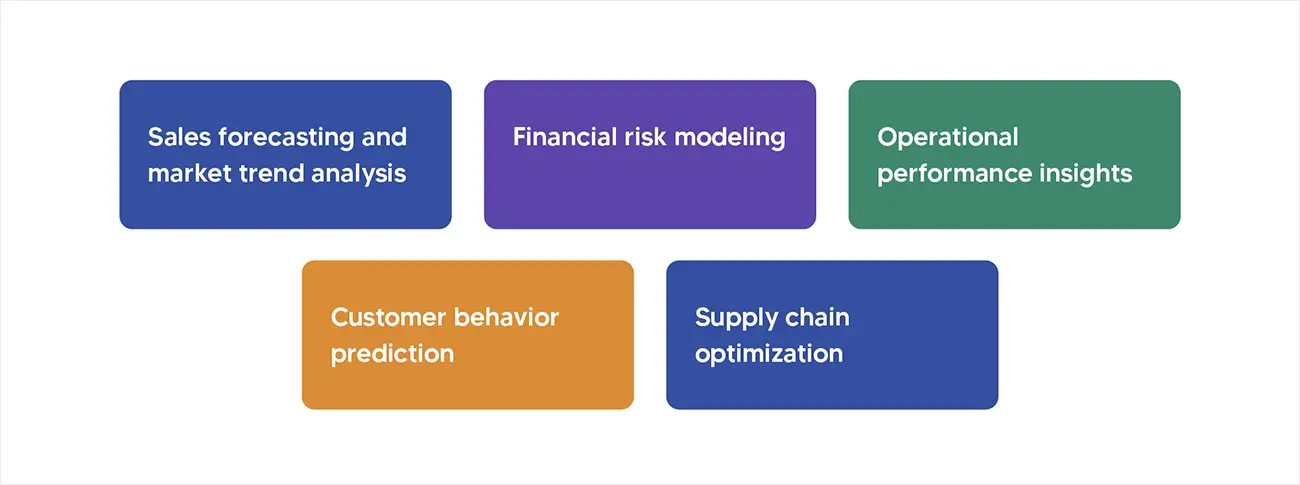Other recent blogs


Let's talk
Reach out, we'd love to hear from you!
85% of organizations have integrated AI agents in at least one workflow, signaling a fundamental shift from basic automation to true autonomous intelligence. From automation to autonomy, agentic AI is reshaping everything when it comes to enterprise operations and real-time business intelligence with purpose-built intelligent agents. When implemented as a data analytics interpreter, these AI agents turn raw insights into autonomous actions for maximum data quality with zero waiting for human commands to analyze, interpret, and act on complex datasets.
Most companies are projecting a 100%+ ROI from agentic AI for data quality. The reason is straightforward - AI in the enterprise is evolving beyond passive tools into proactive decision-makers. In this comprehensive guide, we will explore how autonomous data analytics interpreters are revolutionizing enterprise business intelligence, delivering unprecedented speed, accuracy, and strategic value across every data-driven function.
What is agentic AI in the enterprise as a real-time autonomous data analytics interpreter?
Agentic AI represents a paradigm shift in enterprise data management, moving beyond traditional query-response systems to autonomous intelligent agents that independently analyze, interpret, and act on data. An Agentic AI Enterprise Data Interpreter functions as a continuous analytical engine that perceives data streams, reasons through complex patterns, executes analytical tasks, and learns from outcomes—all without constant human intervention.
Agentic AI interpreters deliver capabilities that fundamentally transform how enterprises leverage information assets.Here’s how:
- Autonomous insight generation: These agents continuously scan datasets to identify trends, outliers, and opportunities without being asked, surfacing business-critical information proactively.
- Contextual understanding: Rather than treating data as isolated numbers, agentic AI understands business context, historical patterns, seasonal variations, and market conditions to provide nuanced interpretations.
- Predictive foresight: By analyzing historical patterns and current trajectories, these systems forecast future scenarios with quantified probabilities, enabling preemptive strategic adjustments.
- Cross-functional synthesis: Agentic interpreters connect insights across traditionally siloed departments—linking sales trends with supply chain capacity, customer sentiment with product roadmaps, and financial metrics with operational efficiency.
- Natural language explanation: Complex analytical findings are translated into executive-friendly narratives, complete with supporting evidence, confidence levels, and recommended actions.
- Continuous improvement: Each interaction refines the agent's understanding of business priorities, data reliability, and decision impact, creating increasingly accurate and relevant outputs over time.
Unlike conventional business intelligence tools that require analysts to formulate specific queries, agentic AI actively monitors enterprise data ecosystems, identifies anomalies, discovers hidden correlations, and generates actionable insights in real-time. These systems integrate with data warehouses, operational databases, streaming sources, and external market feeds to maintain comprehensive situational awareness.
How does agentic AI work as an autonomous interpreter?
An agentic data analytics interpreter operates through a sophisticated "Perceive, Reason, Act, and Learn" (PRAL) cycle that enables true autonomy in data interpretation:

- Perceive
The perception phase involves continuous monitoring of diverse data sources across the enterprise ecosystem. Agents ingest structured data from transactional systems, semi-structured logs from operational platforms, unstructured text from customer interactions, and streaming telemetry from IoT devices. Advanced sensors detect data quality issues, schema changes, and anomalies in real-time, ensuring analytical reliability.
- Reason
During the reasoning phase, the agent applies multiple analytical frameworks simultaneously. Statistical models identify correlations and trends, machine learning algorithms detect complex non-linear patterns, domain-specific rules validate findings against business logic, and causal inference techniques distinguish correlation from causation. The agent evaluates competing hypotheses, weighs evidence quality, and formulates probabilistic conclusions about data meaning and implications.
- Act
The action phase translates insights into tangible outputs. Agents generate comprehensive reports with visualizations, trigger automated workflows based on predefined thresholds, send targeted alerts to relevant stakeholders, update predictive models with fresh findings, and even execute approved business processes like inventory reorders or pricing adjustments. Actions are always traceable and reversible, maintaining human oversight where required.
- Learn
The learning component ensures continuous enhancement of interpretive accuracy. Agents track which insights led to successful business outcomes, identify interpretation errors through feedback loops, adapt analytical approaches based on changing data patterns, and refine communication strategies to match stakeholder preferences. Big data interpretation capabilities expand exponentially as the system accumulates experience across diverse analytical scenarios.
This PRAL architecture enables agentic AI to function as a self-sufficient analytical partner rather than a passive tool, fundamentally changing how enterprises extract value from their data assets.
How is agentic AI different from traditional data analysis models?
The evolution from traditional business intelligence to agentic AI represents a fundamental architectural shift in how enterprises approach data-driven decision-making. While conventional analytics platforms have served organizations well for decades, their inherent limitations become increasingly apparent in today's complex, fast-moving business environment.
Traditional data analysis operates on a demand-driven model where business users or analysts formulate specific questions, design appropriate queries, execute analytical procedures, and interpret results manually. This approach requires deep technical expertise, consumes significant time, and scales linearly with analyst capacity. Each new question initiates a fresh analytical cycle, creating delays between insight needs and actionable answers.
In contrast, agentic AI functions as an always-on analytical partner that continuously monitors enterprise data ecosystems, autonomously identifies patterns worthy of investigation, and surfaces insights before stakeholders realize they need them. This supply-driven intelligence model inverts the traditional paradigm—rather than answering predefined questions, agentic systems ask better questions and provide answers simultaneously.
Here’s a quick comparative analysis between traditional agents vs agentic approaches
| Dimension | Traditional Data Analysis | Agentic AI Interpreters |
|---|---|---|
| Initiation | Requires explicit human queries and requests | Proactively identifies analytical opportunities autonomously |
| Scope | Answers specific predefined questions | Explores data comprehensively to discover unexpected insights |
| Speed | Hours to days for complex analyses | Real-time continuous interpretation with instant alerts |
| Adaptability | Fixed analytical frameworks and methodologies | Dynamically adjusts approaches based on data characteristics |
| Technology used | A refresh rarely requires changes to the technology part of the website. | Often requires a shift or upgrade in the tech stack or platform used such as a new CMS (Content Managed System). |
| Context | Limited to query parameters provided | Incorporates broad business context and historical knowledge |
| Scalability | Constrained by analyst availability and capacity | Scales infinitely across unlimited data sources simultaneously |
| Learning | Static models requiring manual retraining | Siloed analytical tools with manual coordination |
| Integration | Siloed analytical tools with manual coordination | Seamlessly orchestrates insights across enterprise systems |
| Communication | Technical outputs requiring interpretation | Natural language narratives tailored to stakeholder needs |
| Decision Support | Passive information provider | Active decision partner with recommendations and rationale |
What are the different types of AI agents used in enterprises?
Understanding the taxonomy of AI agents helps organizations deploy the right architecture for specific analytical needs. Each agent type serves distinct roles within enterprise data ecosystems, with sophisticated deployments often combining multiple architectures to balance autonomy, interpretability, and strategic value. Let’s explore different types of AI agents business leaders can rely upon to improve enterprise business intelligence:
- Reactive agents
Reactive agents operate on predefined rule-based logic, responding to specific data conditions with predetermined actions. These agents excel at high-frequency, low-complexity tasks like threshold monitoring and compliance checks. For example, a reactive agent might flag transactions exceeding credit limits or identify inventory levels falling below reorder points. While lacking learning capabilities, their simplicity ensures reliability and transparency in regulated environments.
- Model-based reflex agents
Model-based agents maintain internal representations of data states and business contexts, enabling more sophisticated decision-making than purely reactive systems. These agents track temporal patterns, understand sequential dependencies, and anticipate future states based on current trajectories. For example, a financial forecasting agent might maintain models of revenue cycles, cost structures, and market dynamics to provide contextualized predictions even when partial data is available.
- Goal-based agents
Goal-based agents are designed to achieve specific business objectives. They formulate and execute multi-step analytical plans to reach defined outcomes. These agents evaluate alternative approaches, optimize resource allocation, and adapt strategies when obstacles emerge. A customer retention agent might analyze churn indicators, test intervention scenarios, and recommend targeted engagement campaigns optimized for retention probability and cost-effectiveness.
- Utility-based agents
Utility-based agents optimize for quantified business value rather than binary goal achievement, weighing trade-offs between competing objectives. These agents incorporate risk preferences, resource constraints, and strategic priorities into decision frameworks. A pricing optimization agent might balance revenue maximization against market share protection and competitive response likelihood, recommending strategies that maximize expected utility across multiple dimensions.
- Learning agents
Learning agents continuously enhance their capabilities through experience, adapting analytical models and decision logic based on outcome feedback. These represent the most advanced form of agentic AI, capable of discovering novel patterns, refining predictive accuracy, and personalizing insights to organizational preferences. Learning agents use AI to complete tasks without the need for human prompts or intervention, making them ideal for complex, evolving analytical challenges where predefined rules prove insufficient.
What are the key benefits of using agentic AI as an autonomous data analytics interpreter?
The deployment of autonomous data analytics interpreters offers significant strategic and operational advantages that fundamentally enhance enterprise business intelligence capabilities:

- Autonomous pattern recognition
Agentic AI continuously scans vast datasets to identify meaningful patterns that human analysts might overlook or lack time to investigate. These systems detect subtle correlations across disparate data sources, recognize emerging trends before they become obvious, and distinguish signal from noise in high-dimensional data spaces. Organizations gain early awareness of market shifts, operational inefficiencies, and customer behavior changes, enabling preemptive strategic responses.
- Real-time anomaly detection
Traditional analytical approaches often discover critical anomalies only during scheduled reporting cycles, creating dangerous blind spots. Autonomous interpreters monitor data streams continuously, applying sophisticated statistical models to instantly identify deviations from expected patterns. Whether detecting fraudulent transactions, equipment failures, supply chain disruptions, or quality defects, these agents alert stakeholders immediately, minimizing damage and enabling rapid intervention.
- Goal-driven data exploration
Rather than waiting for specific analytical requests, agentic AI actively explores data guided by organizational objectives. These systems formulate hypotheses about what might drive business outcomes, design analytical experiments to test theories, and pursue promising investigative threads autonomously. This proactive approach uncovers optimization opportunities, competitive advantages, and strategic blind spots that passive analytical tools would never surface.
- Intelligent alerting and recommendations
Beyond simply flagging issues, agentic interpreters provide contextualized recommendations with supporting rationale. Alerts include severity assessments, predicted impacts, suggested responses, and confidence intervals, enabling stakeholders to make informed decisions quickly. The system learns which alerts matter most to different roles, reducing notification fatigue while ensuring critical issues receive immediate attention.
- Cost reduction
Most companies are projecting a 100%+ ROI from agentic AI, driven largely by operational efficiency gains. Autonomous interpreters reduce the analyst headcount required for routine reporting, accelerate insight generation from days to seconds, minimize costly errors through consistent analytical rigor, and optimize resource allocation by identifying waste and inefficiency. Organizations redirect human expertise toward strategic initiatives while agents handle high-volume analytical workloads.
- Automated operational workflows
Agentic AI bridges the gap between insight and action by automatically executing approved business processes. When predefined conditions are met—inventory depletion, demand surges, quality issues, or market opportunities—agents can trigger procurement orders, adjust pricing, reallocate resources, or initiate customer communications without human intervention. This automation accelerates response times, ensures consistency, and frees personnel for complex judgment calls.
- Proactive decision-making
Perhaps most transformatively, autonomous interpreters shift organizations from reactive to anticipatory operations. Rather than responding to problems after they manifest, enterprises identify risks and opportunities while intervention remains effective. Predictive maintenance prevents equipment failures, demand forecasting optimizes inventory levels, churn prediction enables retention interventions, and market analysis informs product roadmaps—all before critical moments pass.
What challenges should enterprises consider when implementing agentic AI interpreters?
Implementing agentic AI as an autonomous interpreter is not without hurdles. Organizations must navigate several significant considerations to realize successful deployments:
- Data quality and governance
Autonomous agents are only as reliable as the data they consume. Poor data quality—incomplete records, inconsistent formats, duplicate entries, or outdated information—leads to flawed interpretations and erroneous recommendations. Enterprises must establish robust data governance frameworks, implement comprehensive quality monitoring, and maintain accurate metadata before deploying agentic systems. The adage "garbage in, garbage out" becomes particularly critical when AI operates autonomously without human validation checkpoints.
- Explainability and trust
Over 40% of agentic AI projects will be canceled by the end of 2027, due to escalating costs, unclear business value or inadequate risk controls. Building stakeholder confidence in autonomous interpretations requires transparent reasoning processes. Black-box algorithms that produce recommendations without comprehensible justification face organizational resistance, particularly when decisions carry financial or reputational consequences. Successful implementations prioritize explainable AI architectures that articulate analytical logic, evidence sources, and confidence levels in human-understandable terms.
- Integration complexity
Enterprise data landscapes are notoriously fragmented, with information scattered across legacy systems, cloud platforms, departmental databases, and external sources. Agentic interpreters require seamless access to comprehensive data ecosystems, necessitating extensive integration work. Organizations must address authentication protocols, data format heterogeneity, latency constraints, and API limitations while maintaining security and compliance standards. The technical lift often exceeds initial estimates, particularly in highly regulated industries.
- Skill gaps and change management
Deploying agentic AI demands new organizational capabilities—data engineering to maintain pipelines, machine learning expertise to optimize models, and business analysts who can effectively collaborate with AI agents. Workforce skills and readiness follow closely at 26% among top AI adoption concerns. Enterprises must invest in upskilling programs, hire specialized talent, and redesign workflows to incorporate autonomous insights effectively. Resistance from analysts who perceive agents as job threats requires proactive change management emphasizing augmentation over replacement.
- Security and compliance risks
Autonomous systems operating with broad data access and decision authority create new security vectors. Malicious actors might manipulate input data to bias interpretations, exploit agent logic to extract sensitive information, or compromise autonomous workflows to disrupt operations. Regulatory frameworks around AI governance, algorithmic accountability, and data privacy continue evolving, creating compliance uncertainty. Organizations must implement rigorous access controls, audit trails, validation protocols, and ethical guidelines to mitigate these risks.
- Cost and resource allocation
While promising substantial ROI, agentic AI implementations require significant upfront investment in infrastructure, talent, and organizational transformation. Computing costs for continuous analytical workloads, licensing fees for enterprise AI platforms, and consulting expenses for implementation support accumulate quickly. Organizations must carefully assess business cases, prioritize high-value use cases, and establish clear success metrics to avoid costly failed pilots.
How is agentic AI being applied across different data functions?
Agentic AI delivers transformative value across diverse analytical domains and demonstrates versatility in addressing varied business challenges when implemented as an Agentic AI Enterprise Data Interpreter for Big Data interpretation. Given below are five top real-life applications:

- Sales forecasting and market trend analysis
Autonomous interpreters revolutionize revenue planning by continuously analyzing sales patterns, market dynamics, competitive positioning, and economic indicators. These agents detect seasonal fluctuations, identify emerging customer segments, predict demand shifts, and assess promotional effectiveness in real-time. By synthesizing internal transaction data with external market intelligence, agentic systems provide nuanced forecasts that account for complex interdependencies traditional models miss. Big data interpretation capabilities enable processing of millions of customer interactions, competitor pricing changes, and macroeconomic signals simultaneously, delivering forecasts that adapt to market volatility instantly.
- Financial risk modeling
In finance, agentic AI continuously monitors credit portfolios, market exposures, liquidity positions, and regulatory capital requirements. These agents simulate stress scenarios, assess concentration risks, detect early warning signals of default or fraud, and recommend hedging strategies dynamically. By analyzing transaction patterns, market correlations, and counterparty behaviors, autonomous interpreters identify emerging risks before they materialize into losses. The systems maintain compliance with evolving regulatory frameworks while optimizing risk-adjusted returns across complex financial instruments.
- Operational performance insights
Manufacturing and service operations leverage agentic interpreters to optimize asset utilization, workforce productivity, quality metrics, and supply chain efficiency. Agents analyze production telemetry, logistics data, workforce schedules, and quality control measurements to identify bottlenecks, predict maintenance needs, optimize throughput, and reduce waste. Real-time monitoring enables immediate response to performance deviations, while historical analysis uncovers systemic improvement opportunities. AI for data quality ensures that operational metrics remain accurate and reliable, providing trustworthy foundations for autonomous optimization.
- Customer behavior prediction
Marketing and customer experience teams deploy agentic AI to understand purchase propensities, churn risks, lifetime value trajectories, and content preferences at individual customer levels. These agents analyze browsing behaviors, transaction histories, support interactions, and engagement patterns to predict the next best actions and personalization strategies. By identifying micro-segments with distinct needs and preferences, autonomous interpreters enable hyper-targeted campaigns that maximize conversion rates and customer satisfaction while minimizing acquisition costs.
- Supply chain optimization
Global supply networks benefit from agentic interpreters that coordinate demand forecasts, inventory positions, supplier reliability, logistics capacity, and cost structures across complex multi-tier ecosystems. These agents optimize procurement timing, warehouse allocations, transportation routes, and contingency strategies to balance service levels against working capital requirements. By anticipating disruptions—weather events, geopolitical risks, supplier issues—and automatically triggering mitigation protocols, autonomous systems enhance resilience while reducing operational costs.
Conclusion: Transform your enterprise data strategy with Kellton
The evolution from passive business intelligence to autonomous agentic AI represents the most significant advancement in enterprise analytics since the advent of data warehousing. Organizations that successfully deploy autonomous data interpreters gain decisive competitive advantages through faster insights, proactive decision-making, and operational optimization at scales impossible with traditional approaches.
However, realizing this transformation requires more than technology acquisition—it demands strategic vision, architectural expertise, and organizational change management. 88% say their team or business function plans to increase AI-related budgets in the next 12 months due to agentic AI, reflecting enterprise recognition of this technology's strategic importance.
Kellton's approach to agentic AI implementation combines deep technical expertise with pragmatic business focus. Our methodology begins with comprehensive data readiness assessments, identifying quick wins while architecting scalable foundations. We design agent architectures tailored to your specific analytical needs, integrate seamlessly with existing technology ecosystems, and establish governance frameworks that balance autonomy with appropriate oversight. Our change management programs ensure your teams embrace AI collaboration rather than resist it, creating sustainable transformation.
Whether you're embarking on your first agentic AI pilot or scaling across enterprise functions, Kellton provides the strategic guidance, technical capabilities, and implementation support to accelerate your journey from automation to true autonomous intelligence.
Ready to transform your data analytics with agentic AI?
Contact Kellton today



